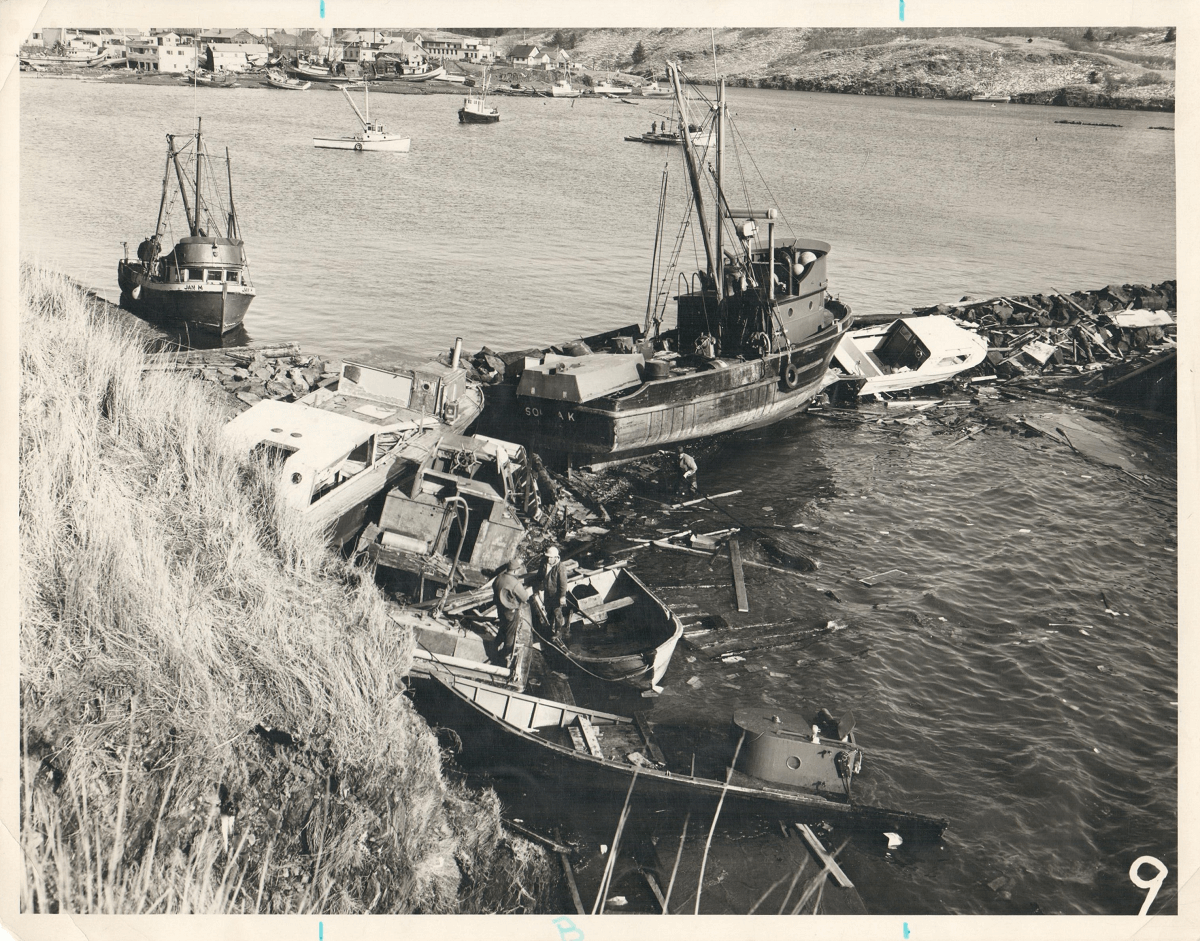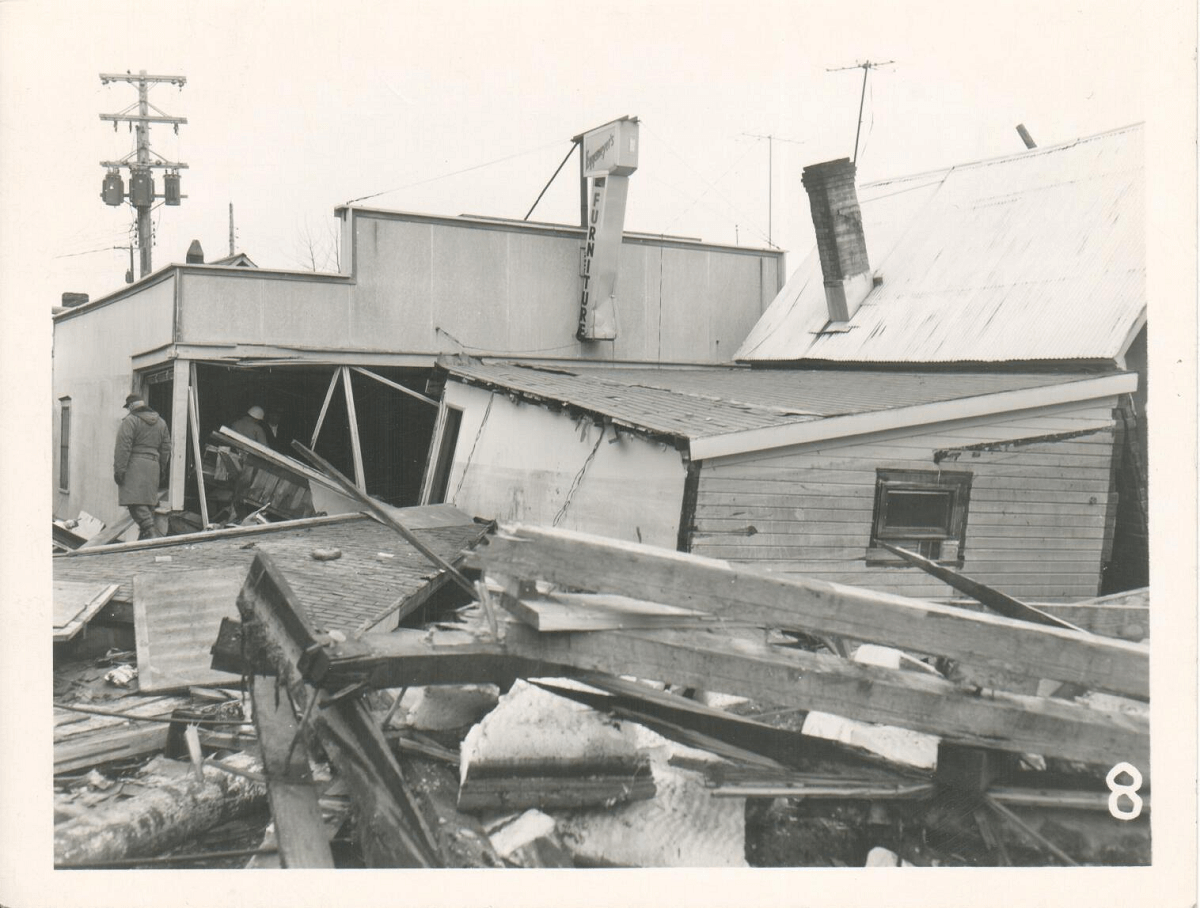Chapter 3: The Tsunami
Listen to Kodiak residents talk about what they saw and heard and how they felt the night the 1964 tsunami hit Kodiak.

When the earth finally quieted after five minutes of intense shaking, most Kodiak residents assumed the worst was over and began putting their houses back in order – re-shelving books, sweeping up broken glass, clearing unfinished dinners from the table.
But their neighbors along the waterfront did not get a chance to start cleaning up. Seeing that the tide was out and the water had receded far beyond the norm, they knew there was only one explanation: a tsunami was racing across the ocean toward Kodiak. Word quickly spread through town and everyone in low-lying areas immediately headed for higher ground. It was none too soon. Within 40 minutes, the first wave had struck.
Skiffs, cabin cruisers and a fishing vessel lay in a heap on what was left of the boat harbor breakwater after the tsunami ravaged the waterfront of downtown Kodiak.
Leif J. Norman photo, March 30, 1964, courtesy of Nancy Norman Sweeney
"When I turned around to look, it looked like just a pile of little kids’ toys in a bathtub, and it looked like some kid had taken his hand and swirled them all around in a great big circle." ~ Chuck Mackey

Those who were downtown when the first wave hit said it came in more like a fast-rising tide than a wave. Seawater silently seeped up through cannery floorboards and waterfront stores before receding, sucking out much of the harbor water with it. The second, larger wave hit downtown Kodiak with even more force about an hour later. The wave stripped the waterfront of canneries and docks, upended boardwalks, and tore buildings from their foundations until it, too, receded.
This aerial view of Kodiak prior to the 1964 earthquake has been edited to show the water inundation from the tsunami. The tsunami that ravaged the waterfront following the earthquake wiped out the entire Erskine commercial holdings and the APA cannery.
Leif J. Norman photo courtesy of Nancy Norman Sweeney
“The only picture of the tidal wave I had seen before was the Japanese print of the tsunami and it’s this huge thing. I was crying, saying, 'Mom, we’re not high enough, we have to higher.'” ~ Mary Cichoski

The largest wave, about 30 feet high, arrived about 10 p.m. It was dark by then and throughout the town the power was out, so residents could only imagine the devastation taking place as they listened through the darkness. They heard the thunderous sounds of buildings collapsing under the weight of the sea and fishing boats, some 90 feet long, crashing into downtown shops and stores like toy boats sloshing around in a bathtub. Before the night was over, the tsunami had flooded buildings and hangers on the Navy Base, demolished the communities of Kaguyak and Afognak, and severely damaged Old Harbor.
Eggemeyer’s Furniture store and many other wood buildings lay in a heap after collapsing under the force of the tsunami that surged through downtown Kodiak.
Leif J. Norman photo courtesy of Nancy Norman Sweeney

When public officials ordered everyone to evacuate low-lying areas and move to higher ground, most people were terrified, not knowing when the waves would arrive or how high they would reach: 20 feet? 50 feet? 100 feet? It was a night the people of Kodiak would never forget.
A piece of driftwood ends up on the shore of Potato Patch Lake and houses float in the middle of the lake after a 30-foot tsunami swept across Mission Road and uprooted everything in its path.
Leif J. Norman photo, March 30, 1964, courtesy of Nancy Norman Sweeney
